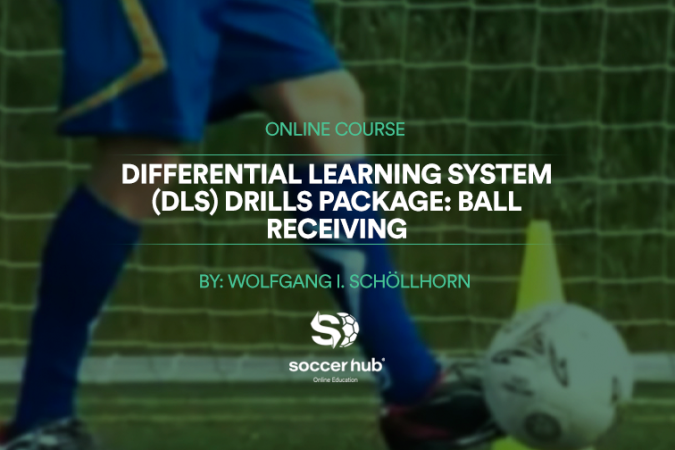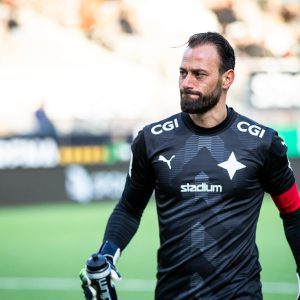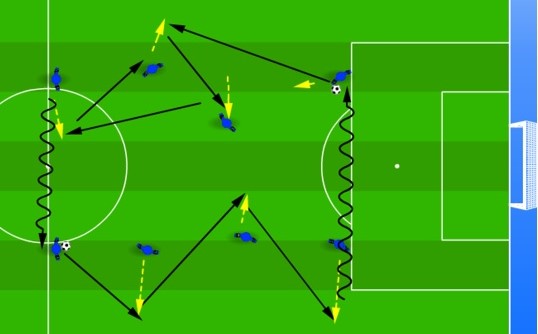

How to keep the connection between drills within the training session? A practical example
When I talk about training methodology and all the options it carries, I always say that there are several ways of winning and loosing, i.e., there isn’t a magic formula that will help us winning all the times. The same methodology I use in a club, can fail in other, because the players are different, the culture may be other, the same with pressure, goals; in other words the context changes and we (coaches) must be aware of that.
Even in these days where the information is very accessible to everyone in all the parts of the world, we can observe training sessions where we observe a lot of drills without connection between each other and even displaced from the game model and specific game strategic plan. It seems in these cases, that the goal is to train drills by it selves. What I propose, within the week and in the training session is to have coherence in the progression of the drills , in the objectives each drill and training sessions aims, transmitting to the players objectively what is intended in each drill and at the same time letting them discover and explore the drill created and learn unconscious repeating the same actions in open context that leave players the capacity of taking decisions.
Practical example of a training session
In the next page I will give an example of a training session and explain my options in it, making clear what are the intended behaviors I want to achieve in the training session, explaining objectives and exercise creation criteria.
The training was targeted to include twenty players plus two goalkeepers (GK). It was included in the middle of the week (Wednesday), in a week with games on Sunday like 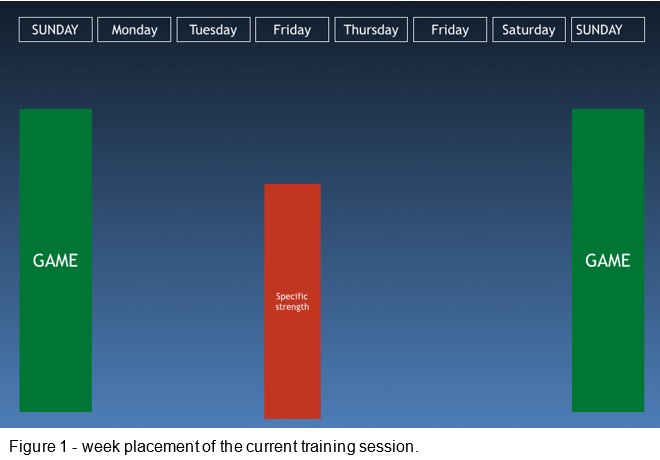
The main goals of the weekly plan are:
1) To develop exterior game play by the wings with the presence of the fullbacks (FB) providing external passing options and crossing in the last third of the pitch;
2) To develop positional play with the “false” wingers (W) appearing in the middle to free space for the FB;
3) To build-up with a line of three players, leaving the FB up in the pitch; and 4) To change the balance dynamic of the team, passing from a line of three plus one (3 defenders + 1 defensive midfielder – DM).
The specific goals of the training session are:
1) To project the FB in the attack, leaving space for one DM to build-up with the central defenders (CD);
2) To improve sectorial defensive organization in a 4-4-2 structure, specially the passage of the false W to defend in the wings;
3) To improve positional play with more playing in the middle (overload) and to accelerate the game by the wings when we are able to attract the opponent to the middles. These goals will be translated to behaviors (coaching points) that will be discriminated in each of the following drills.
In this training session we will mix-up some group (FB, CD, DM AND W), sectoral and intrasectoral (defense plus midfielders and midfield plus attack).
Initial part
We started the training session with a drill that aims the general activation of the players and at the same time places the focus the players in the training contents.
Description: 3 players in the markers where are the balls and 2 in the others. The ball is passed creating various dynamics, but the basic is to circulate the ball always to the following passing station. The players occupies the marker where he previous passed the ball.
Coaching points:
1) Improve positional play: distinguish the feet in a diagonal position to the ball to control the ball and the space in the back;
2) Appear in the space in the right timing (when the colleague orientates to the space) to gain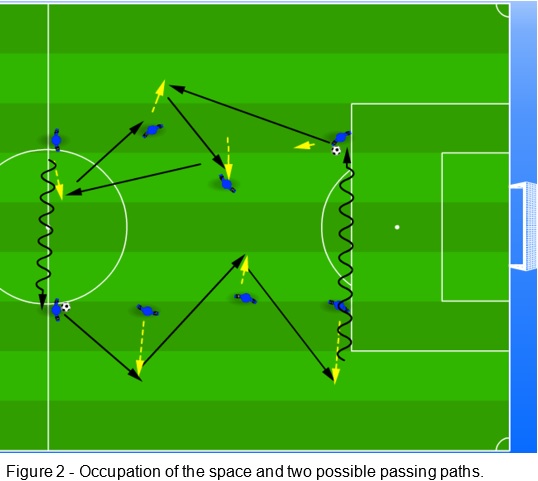
defender;
3) Give importance to the first touch no attack the depth and get progression in the offensive play;
4) Give power to the ball to break opponents lines;
5) Introduce other concepts like “the 3rd man” to attain progression, by jumping one line to free the man of that line to
receive the frontal support.
Progression: We can use this drill in the same day (after a more intense specific mobilization) putting two FB playing wide open to cross, introducing the concepts and behaviors we want.
Then we intensified the training session in a more open situation which aimed:
1) To improve ball circulation with a better control of the space (check constantly the space to understand what is the better action to do, distinguish supports, avoid supports movements to not close the space/time to the ball carrier);
2) To have FB open to give width to the game, with a fast ball circulation to get space to progress;
3) To improve the capacity to break lines by passing the ball throw the defensive lines;
4) To react in a very strong manner after the lost of the ball possession, closing down the ball and the space near it.
Description: Two spaces of 20×18 meters with a gap of 5 meters between those. The attacking teams are placed one in each and the defending team is divided: three players in the pitch 
Progression: To improve ball circulation, we can limit the maximum of passes for players or oblige players to fulfill a minimum number of passes before play in the other side . Personally, I don’t like to abuse of these kind of rules, because one of the difficulties I feel in training is to get players to adjust the intensity of ball circulation to the situation and therefore there are situations where we need players to play with a few touches and in others players need to temporize (for example, to get passing lines).
Main part
This part is divided between two drills: the first is aimed to improve the intersectional connection and the second the ball circulation in the middle to accelerate the game by the inside or if not possible, by the wings. In both cases, the behaviors of the FB in function of the game stage or of the pitch area is focused.
The first drill of the main part consists in a GK+6×6+GK with 2 outside supports and aims: 1) To improve the offensive role of the FB providing an outside support during build-up and creation; 2) To work on the spatial occupation between the FB and the “false” W, with the first playing mainly in the outside and the W playing inside; 3) To improve the defensive organization in a 4-4-2 structure (defensive line + DM) and specially between the 2 strikers (ST) and the midfield line (placement of the “false” W closing in the wings); 5) To get a better reaction to the loss of the ball possession (ball and space around it) and if unsuccessful to improve defensive recovery to close progression to vital areas.
Description: A pitch in the central zone of the pitch divided in two. The yellow team plays in a positional attack, with the supports (FB in white) providing width to the gameplay of this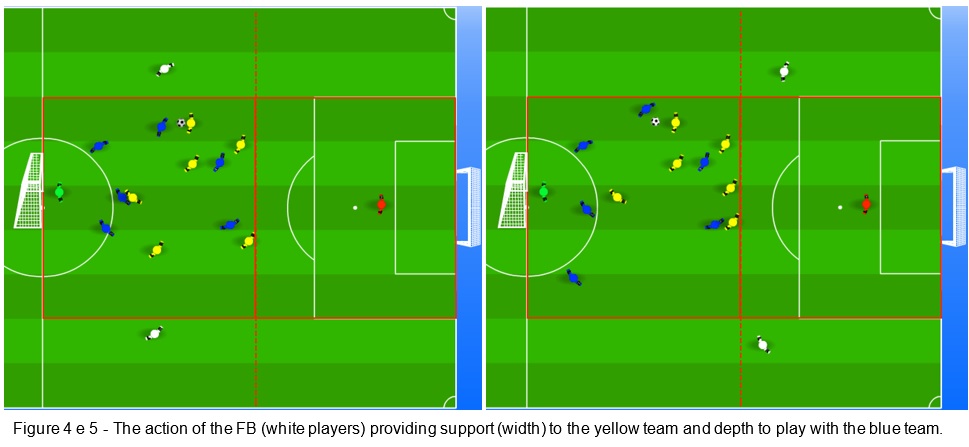
Progression: In the blue team attack, let the supports to appear inside during transition and also near end zones.
Note: The team that is outside, performs some complementary workouts of strength, proprioception and others to potentiate capacities and/or prevent injuries.
The last drill is a more collective situation, in a reduced space, obliging the players to decide fast and the teams to be intense when defending. This drill intends to consolidate the behaviors worked in the previous ones of the training session. It aims the following behaviors:
1) To start playing from the back with a line of three players (a DM enters back in the middle or in the outside of the two CD), projecting the FB;
2) To improve positional play in the middle with the W inside to progress or to accelerate by the outside with the evolvement of the FB; 3) To incentive the lateral movements of the ST appearing in the back of the opposite FB, when the ball is in his Fb in a lower area of the pitch.
Description: The drills consists in a GK+10×10+GK situation, played in half of the regulamentar football pitch. The wings are marked as a reference to the W to play in the limit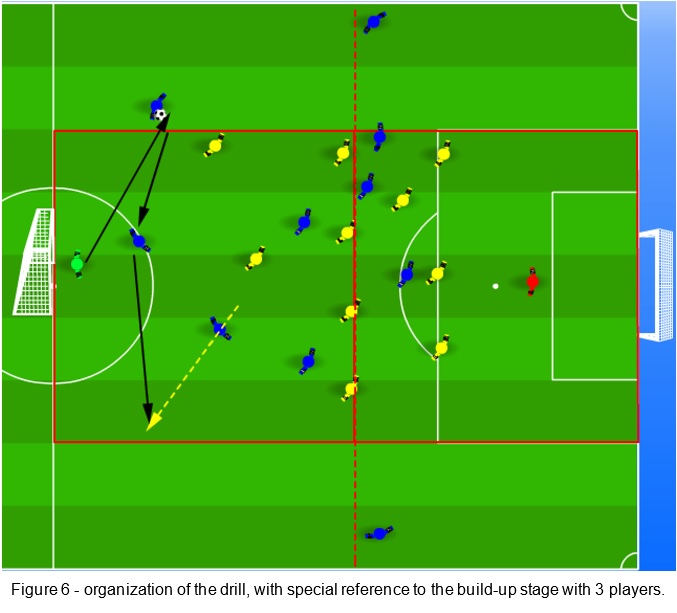
1) In the lower area (bellow the central line) the players can only give a maximum of two consecutive touches in each possession, except when they attack with the ball (conduct the ball in the direction of the other team’s goal);
2) The FB can’t enter in the lower part of the pitch (build-up).
Progression: We can have a bigger pitch, with three sectors and create several rules regarding spatial occupation, for example, just allowing movements of the ST to the wings in the last third when the ball is low in the pitch and the FB are providing a safe passing line to leave pressure. Other option, among many, can be to oblige a ST to be always in the last sector, encouraging one of the them to play more in support to the ball carrier and the other being deep to fixate the CD and/or to explore the gaps created by the other ST.
To sum-up…
The coach as an unfindable resource of options to implement in training, but from the amateur level, where coaches have few training sessions to operationalize how ideas, to the high-level where the competition schedule is so tight that doesn’t leave much space (beside recovery and playing) to train, it’s crucial to implement well the scarce time to train. In this time the drills must be build-up from real match situation (opposite to unreal and decontextualized training situations), that can be more or less open regarding decision-making, but must be real and so prepare players to the competition.
The ideal is also to reinforce the goals he have when implementing some situational drills, that grow in complexity during the training session, but focus the most important behaviors regarding game model development and/or specific strategic options. The same should be regarding in the training week, always giving specific importance in each day to a portion of the team’s dynamics or to the collective function, to the physical dominant, being assertive in the goals stablished for the training session.
Find more in the online course: How to build a Soccer Game Model?
Follow us on Facebook!
Categories
Latest Courses
-
9 Lessons
-
1 Lesson
-
6 Lessons
You May Also Like
- Blog
- August 1, 2022
- Blog
- June 3, 2022
- Blog
- May 27, 2022
Developed by Brandit Digital Media Services.

